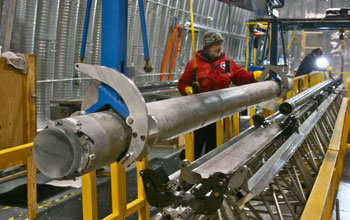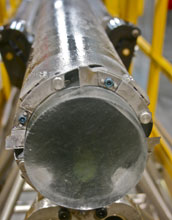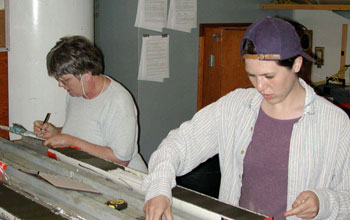Reconstruction of Earth history shows significance of temperature rise.-

Scientists look at an ice core from the West Antarctic Ice Sheet Divide coring site.
Credit: Thomas Bauska, OSU
Download the high-resolution JPG version of the image. (1.1 MB)

A West Antarctic Ice Sheet Divide ice core barrel is shown. Cores show past air temperatures.
Credit: Thomas Bauska, OSU
Download the high-resolution JPG version of the image. (1.4 MB)

An ice core taken from the West Antarctic Ice Sheet Divide is shown in its sampling barrel.
Credit: Thomas Bauska, OSU
Download the high-resolution JPG version of the image. (1.3 MB)

Deploying a core barrel from a research vessel; it will bring back sea-floor sediment.
Credit: Nick Pisias, OSU
Download the high-resolution JPG version of the image. (365 KB)

Sediment cores from the deep ocean tell scientists about past sea surface temperatures.
Credit: Nick Pisias, OSU
Download the high-resolution JPG version of the image. (220 KB)

The researchers' results are described in the March 8 issue of the journal Science.
Credit: Copyright AAAS 2013
Download the high-resolution JPG version of the image. (239 KB)
With data from 73 ice and sediment core monitoring sites around the
world, scientists have reconstructed Earth's temperature history back to
the end of the last Ice Age.
The analysis reveals that the planet today is warmer than it's been during 70 to 80 percent of the last 11,300 years.
Results
of the study, by researchers at Oregon State University (OSU) and
Harvard University, are published this week in a paper in the journal Science.
Lead
paper author Shaun Marcott of OSU says that previous research on past
global temperature change has largely focused on the last 2,000 years.
Extending
the reconstruction of global temperatures back to the end of the last
Ice Age puts today's climate into a larger context.
"We already
knew that on a global scale, Earth is warmer today than it was over much
of the past 2,000 years," Marcott says. "Now we know that it is warmer
than most of the past 11,300 years."
"The last century stands out
as the anomaly in this record of global temperature since the end of the
last ice age," says Candace Major, program director in the National
Science Foundation's (NSF) Division of Ocean Sciences. The research was
funded by the Paleoclimate Program in NSF’s Division of Atmospheric and
Geospace Sciences.
"This research shows that we've experienced
almost the same range of temperature change since the beginning of the
industrial revolution," says Major, "as over the previous 11,000 years
of Earth history--but this change happened a lot more quickly."
Of
concern are projections of global temperature for the year 2100, when
climate models evaluated by the Intergovernmental Panel on Climate
Change show that temperatures will exceed the warmest temperatures
during the 11,300-year period known as the Holocene under all plausible
greenhouse gas emission scenarios.
Peter Clark, an OSU paleoclimatologist and co-author of the Science paper, says that many previous temperature reconstructions were regional and not placed in a global context.
"When
you just look at one part of the world, temperature history can be
affected by regional climate processes like El Niño or monsoon
variations," says Clark.
"But when you combine data from sites
around the world, you can average out those regional anomalies and get a
clear sense of the Earth's global temperature history."
What that
history shows, the researchers say, is that during the last 5,000
years, the Earth on average cooled about 1.3 degrees Fahrenheit--until
the last 100 years, when it warmed about 1.3 degrees F.
The
largest changes were in the Northern Hemisphere, where there are more
land masses and larger human populations than in the Southern
Hemisphere.
Climate models project that global temperature will
rise another 2.0 to 11.5 degrees F by the end of this century, largely
dependent on the magnitude of carbon emissions.
"What is most
troubling," Clark says, "is that this warming will be significantly
greater than at any time during the past 11,300 years."
Marcott
says that one of the natural factors affecting global temperatures
during the last 11,300 years is a gradual change in the distribution of
solar insolation linked with Earth's position relative to the sun.
"During
the warmest period of the Holocene, the Earth was positioned such that
Northern Hemisphere summers warmed more," Marcott says.
"As the
Earth's orientation changed, Northern Hemisphere summers became cooler,
and we should now be near the bottom of this long-term cooling
trend--but obviously, we're not."
The research team, which
included Jeremy Shakun of Harvard and Alan Mix of OSU, primarily used
fossils from ocean sediment cores and terrestrial archives to
reconstruct the temperature history.
The chemical and physical
characteristics of the fossils--including the species as well as their
chemical composition and isotopic ratios--provide reliable proxy records
for past temperatures by calibrating them to modern temperature
records.
Analyses of data from the 73 sites allow a global picture
of the Earth's history and provide a new context for climate change
analysis.
"The Earth's climate is complex and responds to multiple
forcings, including carbon dioxide and solar insolation," Marcott says.
"Both changed very slowly over the past 11,000 years. But in the
last 100 years, the increase in carbon dioxide through increased
emissions from human activities has been significant.
"It's the only variable that can best explain the rapid increase in global temperatures."
-NSF-
Media Contacts
Cheryl Dybas, NSF (703) 292-7734 cdybas@nsf.gov
Mark Floyd, OSU (541) 737-0788 mark.floyd@oregonstate.edu
Mark Floyd, OSU (541) 737-0788 mark.floyd@oregonstate.edu
The National Science Foundation (NSF) is an independent federal
agency that supports fundamental research and education across all
fields of science and engineering. In fiscal year (FY) 2012, its budget
is $7.0 billion. NSF funds reach all 50 states through grants to nearly
2,000 colleges, universities and other institutions. Each year, NSF
receives over 50,000 competitive requests for funding, and makes about
11,000 new funding awards. NSF also awards nearly $420 million in
professional and service contracts yearly.
Useful NSF Web Sites:
NSF Home Page: http://www.nsf.gov
NSF News: http://www.nsf.gov/news/
For the News Media: http://www.nsf.gov/news/newsroom.jsp
Science and Engineering Statistics: http://www.nsf.gov/statistics/
Awards Searches: http://www.nsf.gov/awardsearch/
The National Science Foundation (NSF).NSF Home Page: http://www.nsf.gov
NSF News: http://www.nsf.gov/news/
For the News Media: http://www.nsf.gov/news/newsroom.jsp
Science and Engineering Statistics: http://www.nsf.gov/statistics/
Awards Searches: http://www.nsf.gov/awardsearch/
GuillermoGonzalo Sánchez Achutegui
ayabaca@gmail.com
ayabaca@hotmail.com
ayabaca@yahoo.com
Inscríbete en el Foro del blog y participa : A Vuelo De Un Quinde - El Foro!

No hay comentarios:
Publicar un comentario